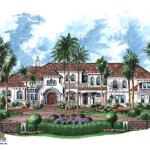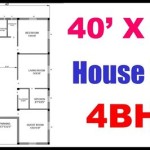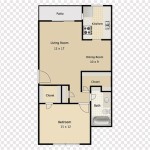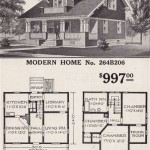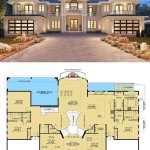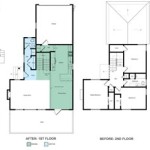L-Shaped House Designs and Floor Plans: A Comprehensive Overview
L-shaped house designs represent a versatile and functional architectural typology, appreciated for their inherent capacity to define outdoor spaces, maximize natural light penetration, and facilitate flexible interior layouts. These designs are particularly well-suited for a variety of lot sizes and orientations, offering a compelling solution for homeowners seeking a balance between aesthetics and practicality.
The fundamental characteristic of an L-shaped house is its two wings that intersect at a right angle, forming the letter "L." This configuration naturally creates a courtyard or private outdoor space within the angle of the "L," which can be adapted for various purposes, such as gardens, patios, swimming pools, or simply a tranquil outdoor retreat. The inherent separation of the wings also allows for the effective zoning of interior spaces, promoting privacy and distinct functional areas within the home.
This article will explore the key aspects of L-shaped house designs and floor plans, including their advantages, common design considerations, structural implications, and relevant examples. Understanding these elements is crucial for architects, builders, and homeowners considering this architectural style.
Advantages of L-Shaped House Designs
L-shaped house designs offer a multitude of advantages, contributing to their enduring popularity in residential architecture. These benefits extend across various aspects of functionality, aesthetics, and spatial organization.
One primary advantage is the creation of a defined outdoor space. The "L" shape inherently forms a courtyard, providing a sense of enclosure and privacy that is often lacking in simpler rectangular or square house designs. This courtyard can be customized to suit individual preferences and lifestyles, becoming a key element of the home's overall design. It can serve as an extension of the living space, offering an area for outdoor dining, relaxation, or recreation. The courtyard also provides a safe and controlled environment for children to play.
Enhanced natural light and ventilation are also significant benefits. The layout of an L-shaped house typically allows for more windows and exterior walls, thus maximizing the opportunity for natural light to enter the interior spaces. This reduces the reliance on artificial lighting, contributing to energy savings and a more pleasant living environment. Furthermore, the increased number of windows facilitates cross-ventilation, improving air circulation and indoor air quality.
The inherent zoning capabilities of an L-shaped design allow for a clear separation of different functional areas within the home. For instance, one wing of the "L" might house the living areas, such as the living room, dining room, and kitchen, while the other wing could accommodate the bedrooms and bathrooms, offering greater privacy and noise reduction for sleeping areas. This zoning approach is particularly beneficial for families with varying schedules and activities.
Adaptability to different site conditions is another advantage. L-shaped houses can be effectively designed to fit irregular or challenging lot shapes. The two wings can be oriented to take advantage of specific views, solar orientation, or to avoid undesirable site features. This flexibility allows for a more customized and site-responsive design compared to more rigid architectural forms.
Key Design Considerations for L-Shaped Houses
While L-shaped house designs offer numerous benefits, careful planning and consideration are essential to ensure a successful outcome. Several key design considerations must be addressed to optimize the functionality, aesthetics, and structural integrity of the building.
Orientation is a crucial factor. The orientation of the "L" shape relative to the sun's path can significantly impact the amount of natural light and solar heat gain within the home. In colder climates, orienting the courtyard towards the south can maximize solar gain during the winter months, reducing heating costs. In warmer climates, shading strategies, such as deep overhangs or strategically placed landscaping, may be necessary to mitigate excessive solar heat gain. The prevailing wind direction should also be considered to optimize natural ventilation.
The size and proportion of the two wings are essential for creating a balanced and harmonious design. The relative lengths and widths of the wings should be carefully considered to ensure that the courtyard is appropriately sized and proportioned. A courtyard that is too small can feel cramped, while one that is too large can feel exposed and less private. The proportions of the wings also influence the overall aesthetic appeal of the house.
Circulation patterns within the house should be carefully planned to ensure smooth and efficient movement between different areas. The intersection of the two wings is often a critical point for circulation, and its design should facilitate easy access to all parts of the house. The placement of hallways and doorways should be carefully considered to minimize wasted space and maximize functionality. Thoughtful consideration should be given to accessibility, particularly for residents with mobility challenges.
Privacy considerations are paramount, especially given the courtyard configuration. While the courtyard offers a sense of privacy from the outside world, it is important to consider the views from adjacent properties. Strategically placed landscaping, fences, or screens can be used to enhance privacy within the courtyard without compromising natural light or ventilation. The placement of windows and doors should also be carefully considered to minimize potential views into private spaces.
Materials and finishes should be selected to complement the overall architectural style and to create a cohesive and inviting atmosphere. The choice of materials can also impact the energy efficiency and durability of the house. Sustainable and locally sourced materials should be considered to minimize the environmental impact of the building.
Structural Implications and Material Considerations
The structural design of an L-shaped house presents specific challenges that must be addressed to ensure stability and longevity. The intersection of the two wings creates a point of concentrated stress, requiring careful attention to the load-bearing capacity of the structure.
The foundation design is critical. The foundation must be robust enough to support the weight of the entire house and to distribute the loads evenly across the ground. Soil conditions must be thoroughly investigated to determine the appropriate type of foundation, which may include a slab-on-grade foundation, a crawl space foundation, or a basement foundation. In areas with unstable soil, additional measures, such as piling or soil stabilization, may be necessary.
The wall construction must be designed to withstand lateral loads, such as wind and seismic forces. Shear walls, which are designed to resist lateral forces, are often used in L-shaped houses to provide additional structural support. The placement and design of shear walls should be carefully coordinated with the overall architectural design to minimize their visual impact.
The roof structure must be designed to effectively transmit loads to the supporting walls. The intersection of the two wings can create complex roof geometries, requiring careful attention to the detailing of the roof framing. Proper insulation and ventilation are essential to prevent moisture buildup and to ensure energy efficiency.
Material selection plays a crucial role in the structural integrity and longevity of an L-shaped house. Wood-frame construction is a common and cost-effective option, but it requires proper detailing to prevent moisture damage and insect infestation. Steel-frame construction offers greater strength and durability, but it is typically more expensive. Concrete block construction is another option that provides good structural performance and fire resistance.
The choice of materials should also consider the aesthetic goals of the design. Brick, stone, and wood siding are popular choices for exterior cladding, while drywall, plaster, and wood paneling are commonly used for interior finishes. The materials should be selected to create a cohesive and inviting atmosphere that reflects the homeowner's personal style.
In summary, L-shaped house designs offer a compelling combination of functionality, aesthetics, and adaptability. However, careful planning and consideration are essential to ensure a successful outcome. By addressing the key design considerations and structural implications, architects, builders, and homeowners can create L-shaped houses that are both beautiful and functional.

53 Best L Shaped House Plans Ideas

European Style House Plan 4 Beds 2 Baths 3904 Sq Ft 520 10 L Shaped Bungalow Floor Plans

Why An L Shaped House Plan Makes The Best Home Design Monster Plans Blog

L Shaped Home Courtyard Villa Resort Style House

L Shaped House Plan With Upstairs Family Room Kitchenette And Home Office 777053mtl Architectural Designs Plans

Plan 531 2 L Shaped House Plans U

L Shaped House Plans With Side Garages Blog Eplans Com

Small Simple L Shaped With Floor Plan Full Tour

L Shape Shaped House Plans One Bedroom

L Shaped House Plan Collection Drummond Plans

